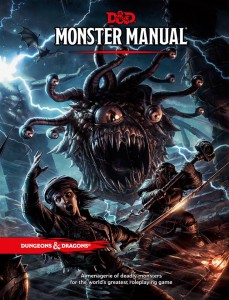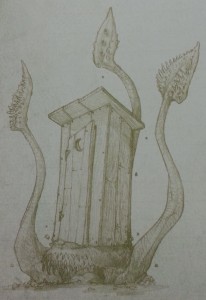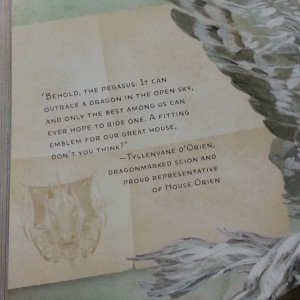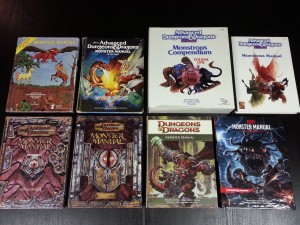 Gamers can pick up their own copy of the 5e Monster Manual today at premier gaming stores. For everyone else the Monster Manual hits shelves on September 30. This is a tricky book to review because it’s just a monster cyclopedia. If you want official 5e monsters stats then you’re going to buy this book no matter what the reviews say.
Gamers can pick up their own copy of the 5e Monster Manual today at premier gaming stores. For everyone else the Monster Manual hits shelves on September 30. This is a tricky book to review because it’s just a monster cyclopedia. If you want official 5e monsters stats then you’re going to buy this book no matter what the reviews say.
To help you decide if you should purchase the new 5e Monster Manual I’ve listed 15 things I like about the Monster Manual and 5 things I don’t like. I’ve tried to be fair with my praise and criticisms so that you can make an informed decision about this quality and value of this book before you buy it.
The fact that my pros outweigh my cons by 3:1 should give you a pretty good idea of where I stand. I think this book is fantastic and you’re about to find out why.
UPDATE: Be sure to listen to a special episode of Recounting Encounters in which Marc, Criag and I talk about what each of us like and dislike about the 5e Monster Manual. Podcast also available through iTunes.
15 Reasons to buy the D&D 5e Monster Manual
1. Strong first impression
The very first page of the book simply says Monster Manual at the top, has the D&D ampersand at the bottom and in the centre is a beautiful full colour illustration of a Dragon, the iconic monster the game is named after. Simple. Elegant. A great first impression.
2. Great art
The art in the new 5e Monster Manual is fantastic; it’s really top notch. As much as I loved that the older editions of D&D had a handful of artists who illustrated the whole book and set a certain tone and standard for monsters, using many artists in the 5e book was an excellent call. It allowed different artists to showcase their own styles while still feeling like they all the monsters live in the same fantasy world. I’d also like to note that all of the art used in the Monster Manual seems to be original. They didn’t just mine the old bestiaries and find images they liked, each monster got new treatment.
3. Talk about variety
There are a lot of monsters in this book. The Monster Manual is 352 pages and there is approximately one monster on every page so 350 different monsters (or more) is a fair estimate. This is more than enough to keep any DM happy for a long time, or at least until they release the inevitable Monster Manual 2. The vast majority of monsters present in the Monster Manual are lower challenge ratings. Personally I’d rather throw a bunch of weaker monsters at the party than just one or two really powerful ones so I’m ok with more lower end monsters. Of course there are some really tough monsters in here too, but not nearly as many.
The folks at The Escapist Magazine have created an interesting graph that maps the number of monsters in the Monster Manual against the Challenge Rating. See below.

4. Legendary creatures
We got a hint of what legendary creatures are like with the D&D Next play test, especially if you ran the D&D Encounters adventure Dead in Thay. Now we get the official descriptions of where legendary actions landed. If a monster has one or more legendary action it will allow them to do something extraordinary, usually when it’s not their turn in the initiative. Legendary creatures might also have Lair Actions that let them do even cooler things if the PCs encounter them where they live. When the initiate count hits 20 the creature can use its legendary lair action. There are also Regional Effects that a legendary creature can cause in the area surrounding their lair, possibly even for miles around.
5. All the iconic creatures are present
In the 4e Monster Manual we only got half of the Dragons, if you wanted the rest you had to wait for the Monster Manual 2. This was a deliberate choice by the 4e designers and one that I’m glad they didn’t repeat in 5e. The idea is that this is THE Monster Manual. Every creature you might want or need is in here, the first time. None of this holding back some creatures for future books to force you to buy the next book. This is the definitive book and in theory the only Monster Manual you should ever need. All the Dragons are here, all the Giants, the Beholder, the Mind Flayer, and the Rust Monster. Every monster you think of when you think of D&D is in this book.
6. Good page layout
I think back to the 1e Monster Manual and the 2e Monstrous Compendium and the pictures for all the monsters were confined to small boxes in the corner of the stat block. Whether the artist was drawing a tiny monsters or a huge monster they usually had the same amount of space in which to do it. The pictures for most monsters in the 5e Monster Manual take up more space on the page than the stat block. The book is visual first and textual second. This makes it more inviting to gamers, especially new gamers. People who pick up the book will be fascinated by the plethora of brightly coloured monsters they see on every single page.
7. Simplicity of the stat blocks
One thing that plagued 4e was that the monsters had powers upon powers. It was a chore to read through everything a powerful monster could do. Many DMs felt that if they didn’t use all of the monster’s powers during combat they were doing something wrong. With 5e everything was simplified, including the monsters. Monsters work like the PCs for the most party. They have weapons (natural or artificial) and they can use them to fight. Some creatures have spells or other magic, but when they do the effects are simple and easy to use. DMs can randomly turn to any page of the 5e Monster Manual and within a minute or less be ready to run that creature. Good luck trying that with a 4e Monster Manual.
8. Iconic character sidebars
In some of the monster descriptions there is a separate side bar that describes an iconic D&D character of that monster type. For example Death Knight (Lord Soth), Demi Lich (Acererak), and Vampire (Strahd Von Zarovich). This adds a bit more flavour if you want to play the monster as these iconic villains. It also encourages new DMs to look up who these characters are and hopefully read some of the source material that made these monsters icons in the first place.
In addition to the great coloured pictures there are sketches throughout the Monster Manual. Many are in the margins of the monster stat block, but you find a few gems in the index. These show monsters in unusual or humourous situations. It reminds you that anything can happen when you play D&D, including a Troll’s body groping the ground for its own head or an Otyugh assaulting a privy. These sketches look like they’re by the same artist who did the sketches in the Conditions section of the PHB.
10. Post-it notes
Many monster entries have what looks like a little post-it note pinned in the corner. These notes share quotes from adventurers who have faced the monster or are from the monsters them
selves to unsuspecting adventurers. It’s a little touch, but it adds personality and often whimsy to a creature’s page.
Although we haven’t see any officially 5e D&D Eberron material yet, evidence that it’s coming is hidden in the Monster Manual. Remember those little post-its we talked about, one of them is from a Dragonmarked Scion of House Orien. Check out the Pegasus entry on pg. #250.
12. Lycanthropy templates
In the Lycanthrope section of the Monster Manual is a neat side bar that has optional mechanics for applying this affliction to your character. The changes are rather simple and elegant, and provide a good guideline for DMs who want to allow this into their campaign. This is clearly one of those modular add-ons they’ve been talking about and I’m sure we’ll see more options like this in the DMG.
13. The 5e treatment for the 4e playable races
In the 5e PHB we got a wide variety of playable races for PCs including the unexpected Dragonborn and Tiefling. We also got a hint of the sub-races such as Drow and Duergar. In the 5e Monster Manual we get a much clearer picture of what the mechanics of these races will look like in the new edition. Most of the playable races from 4e are covered in the PHB and Monster Manual including the Pixie, Revenant, Minotaur, Thri-Kreen, and Githzerai. The Monster Manual doesn’t give actual mechanics for playing these creatures as PC, but any DM who is wondering how that might look can find the inspiration they need in these entires. The most notable races missing are the Warforged (Eberron), Shifter (Eberron), Goliath (Dark Sun), and Mul (Dark Sun). Perhaps these were intentionally held back so that they could be used in releases for these campaign-specific creatures, much like they were for 4e.
14. Appendix B: Nonplayer Characters
In a book filled with fantastic creatures and beasts of legend it’s refreshing to find 20 NPCs in the back of the book. These NPCs are a good cross section of the regular people that inhabit most D&D worlds. What impressed me most was that they weren’t all just weak CR 1 people. Some of these NPCs are really tough, making it easier for DMs to keep using these NPCs as the party advances.
15. Disclaimer
So far all of the D&D rule books have had a humourous disclaimer. The Starter Set, PHB, online DMG, and now the Monster Manual all have a different and equally funny disclaimer. Here’s the one from the Monster Manual. If you follow me on Twitter (@ameron_dm) you may have seen this already when I Tweeted it out at GenCon in August. Enjoy.
Disclaimer: Any similarities between monsters depicted in this book and monsters that actually exist are purely coincidental. That goes double for Mind Flayers, which absolutely, utterly, and completely do not exist, nor do they secretly run the D&D team. Do we really need a disclaimer to tell you that? You shouldn’t use your brain to consider such irrational thoughts. They only make the mind cluttered, confused, and unpleasantly chewy. A good brain is nice, tender, and barely used. Go ahead, put down this book and watch some reality TV or Internet cat videos. They’re really funny these days. You won’t regret it. We say this only because we love you and your juicy, succulent gamer brain.
5 Reasons not to buy the D&D 5e Monster Manual
1. The price
The cover price on the 5e Monster Manual is $49.95 US and $58.00 CAN. That’s a hefty price tag. Assuming you’ve already bought a PHB, dice, and possibly the Starter Set, the costs of getting into D&D add up fast. However, everyone in a gaming group doesn’t need a Monster Manual so if the cost were to be shared by all the players that makes the hit a bit easier to take. Looking back to 4e, the Monster Manual was $35.95 US and $39.95 CAN but the book only had 282 pages (vs. 352 for this book). So you certainly get more bang for your buck. If we look at how heavily the PHB was discounted at many FLGS and online I think we’ll find that we don’t end up paying anywhere near the full cover price for this book which also makes the price easier to justify.
2. Poor indexing
The table of contents on pg. #3 lists all the entries alphabetically. The Index on pg. #351-352 lists every creature alphabetically. These lists are different, but obviously similar. Some entries have multiple creatures, Dragons for example are listed as one entry in the table of contents, but in the index each Dragon is listed by colour and age. So neither Adult Red Dragon, nor Young Blue Dragon are in the TOC but they do have their own listing in the index. What bothered me a little bit about this was that Dragons are not listed in the index under “D” rather they’re listed alphabetically by age. So Young Blue Dragon is found under “Y” for Young. In my mind “B” for Blue Dragon, Young or “D” for Dragon, Young Blue would have made more sense. This is a fairly minor criticism and I can still logically find the monster I’m looking for easily enough.
What is a bigger criticism is that there is no list of monster by challenge rating. With the TOC and Index being so similar they could have easily left one out and added a listing of monsters by challenge rating. This omission is certainly more noteworthy than poor alphabetizing.
Thankfully the gaming community has already addressed this oversight. Miek Shea of SlyFlourish has created an index of Monsters by CR. Thanks to Mike for taking care of this so quickly and sharing with the gaming community. You can read Mike’s review of the Monster Manual at Critical Hits.
UPDATE: Wizards has now released an official PDF that organizes the Monsters by Challenge Rating.
3. Misprinted pages
If you’re buying a Monster Manual off the shelf please take a second to look at the Lizardman entry on pgs. #204-205. In the first printing of the Monster Manual these pages and a few others have blurred text. It’s not a huge deal, but you might as well make sure the book you’re about to buy is perfect. In newer printings this was corrected so be wary.
UPDATE: There have been other reports of more serious printing issues. The worst I’ve seen so far is on the Gargoyle entry. If your book has problem pages you can send it back to Wizards for a replacement. See Dungeons & Dragons: Replacing Defective Product.
4. Free monsters are already available
The 5e D&D basic rules are currently available for free on the Wizards of the Coast Website. They include a trimmed down version of the PHB and a trimmed down version of the DMG which included many of the most iconic D&D monsters (50 pages worth). There are also a few monsters in the Hoard of the Dragon Queen adventure, some in the Starter Set, and for DMs running D&D Encounters at their FLGS there is a free PDF monster supplement. So with all of these monsters already out there do you need to buy the Monster Manual? It depends how much variety you’re looking for.
Also keep in mind that Dungeonscape is on the horizon. When it’s released will all of the monster be available in an online database like they were for 4e? If so, why bother buying the hardcover book? It’s not like there’s a code or some other way to prove you’ve got a Monster Manual and therefore are entitled to some kind of discount or exclusive content should digital copies become available.
They say you shouldn’t judge a book by its cover, and let’s hope that’s true for the 5e Monster Manual. I think this is a terrible cover. It’s way too dark. It’s hard to make out the details until you pick it up and examine it closely. In my opinion it lacks a wow factor that will entice people to pick it up and flip through the pages. I like the idea of using a Beholder on the cover, they’re iconic D&D monsters, but the colours are so dark everything just blurs together.
Take the Poll
[poll id=”47″]
Final Thoughts
The D&D 5e Monster Manual is a great book. I don’t think I’m alone when I say that this is the best single Monster Manual D&D has ever seen. It’s not perfect, but it’s pretty close. Every DM will want to own this book, and a lot of regular players will likely pick this up as well.
Wizard set the bar pretty high with the 5e Player’s Handbook and they’ve surpassed that high water mark with the Monster Manual. The DMG coming in November has a tough legacy to live up to.
- D&D 5e Monster Manual: 10 on a d10
What do you think of the new 5e Monster Manual? Do you agree/disagree with my lists? Please feel free to add any additional points you may have in the comments below.
 Looking for instant updates? Subscribe to the Dungeon’s Master feed!
Looking for instant updates? Subscribe to the Dungeon’s Master feed!



16 replies on “Review: Monster Manual (5e D&D)”
Great review! Although I’m sure I’ll rush out and get my copy today, I’ll keep an eye out for the one with the cleaner pages for my son.
Looking forward to using a good lair monster
Great review. Solid points. Another positive I would have added to the list is the fact that many entries provide either some backstory (inspiration for GMs) or how to play the monster, which previous manuals sorely lacked.
I think you — and everyone else who has pointed out the missing CR Index — are absolutely right. Also, indexing Dragons by age is completely wonky. Hopefully they will fix this in a future reprinting. I’d buy it all over again for those fixes.
The shipment I received had a dozen books with black streaks across pages 140 and 141.
I fundamentally disagree with your assessment on point 7. In the 4th edition MM, monsters were self contained, everything you needed to run them was right there. You absolutely could flip the book open, pick a monster and use it. In other editions (including 5th) if a monster has spells that is simply not the case.
Pretty much the entirety of the DM’s basic rules download is free monsters. http://dnd.wizards.com/articles/features/basicrules
@Loz
Fair point. Let me try to clarify my thoughts on this one. In 5e monsters simply have weapon names and the relevant numbers, such as +5 to attack & 1d10 damage. The vast majority of monsters in 5e work this way. Whereas in 4e every attack has some specially named power that usually did more than just damage. To further complicate things two similar monsters that had similar attacks would have powers called different things in 4e, so even though you’d become familiar with Orcs (for example) if you changed them to Hobgoblins it took some time to get to know the new monsters and how they work. In 5e this change would take about 2 seconds since these monsters both attack with normal weapons. The exception to this whole argument is monster that cast spells, as you correctly pointed out. However, as DMs get more familiar with the most common spells this will be less of an issue. So again, good comment and quite correct.
@Joshua R. Poulson
Well look at that. I must have missed this PDF. Now I’ll have to adjust my point in the article. Thanks for the heads up!
I’m going to disagree with your take on the cover. It is definitely the best drawn cover out of all of them (because white backgrounds SCREAM imagination). It also has a lot of depth. If you look closely you can see the Beholder is missing a tooth. Granted you might have to squint and put your face close to the book to notice the details in the dark night colours. I put my vote on the new cover. Although I do admit that I like the look of the 3rd editions books, with that Tome of Knowledge feel towards them.
@Carl the Paladin
I know I’m going to take a lot of flack for my criticism of the cover. When I asked my group they all loved it. I’m not denying that there is a lot of great detail, I just think that it’s too dark and it’s hard to see all those details from afar. The cover should entice, and make you want to pick up the book. I just don’t think the 5e Monster Manual cover does that. At least not for me. I’m sure I’m going to have to agree to disagree with a lot of people on this one.
Bad cover? Are u sure?
Just picked up the Monster Manual and love it. Great piece of work.
Having not played since 2nd edition though, and recognising that the new monster entry format is superior, I still kind of miss some of the specific details that the 2nd edition stat blocks provided.
For instance, I can see the Kraken is “gargantuan” but how big is that? There’s a guide to say it takes up and area 20′ x 20′ (or larger!?) presumably for board play, but I want the wow factor of saying this guy is 100′ long!
It may be that some of my perceived stat gaps will be bridged by the DMG, for example, I believe there will be encounter building advice to size the number of any creature appearing, rather than the 2nd edition No. Appearing stat.
But I’m still missing that bit of detail. Stupid, I know. Otherwise, as per most other reviews I’ve seen, still an awesome product!
WotC has made an official PDF with monsters by CR available now.also lists the XP value with the CR.
http://media.wizards.com/2014/downloads/dnd/MM_MonstersCR.pdf
Agreed, this is the king of MMs. Only criticism is that I wish the xp/CR was up beside or under the creature name, where I’m used to seeing them, not embedded deep in the stat block mixed up with languages/senses/saving throw info. I will get used to it though.
I was going to agree with Loz, but I see you do as well.
I’m still commenting, however, to counter Mark J’s point. Both the 3.5 and 4E Monster Manuals contained sections on backstory and how-to for their monsters. The original 4E entries were lackluster in this regard, but the later 4E Monster Vaults contained multiple pages of backstory and detail for each entry.
I agree it is overall a great book, but one thing I’d add to the con list is no entry in stat block or at least an appendix for climate/terrain. This makes easy world building or quick encounter building more difficult since it is buried in the descriptions.
I’m glad Wizards finally responded to the CR issue, but they should’ve thought of that ahead of time. [Also I hope the pages don’t start falling out like the ones in my PHB are.]